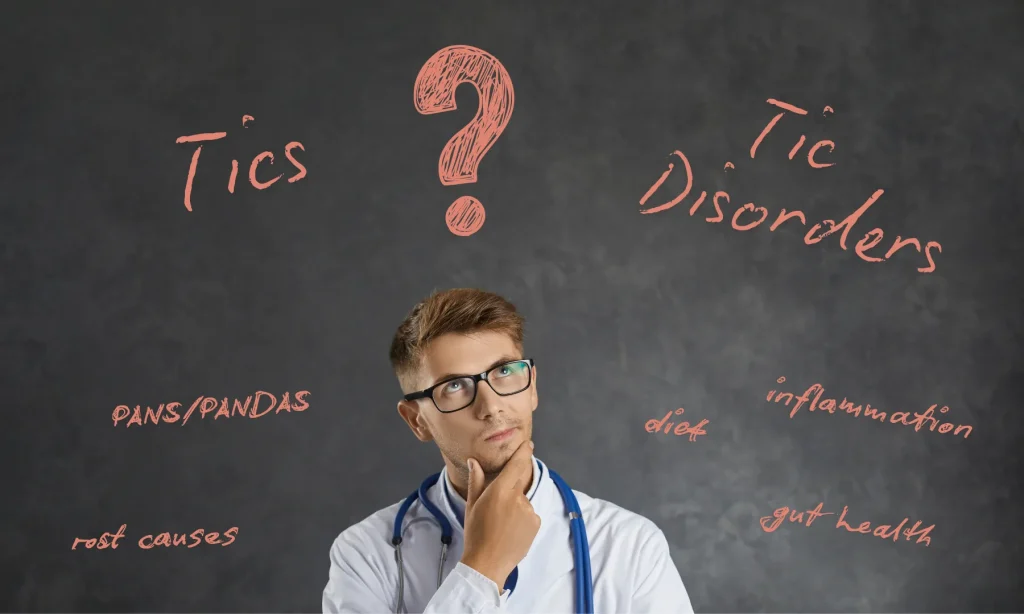Does it seem to you that no one truly comprehends the chaos associated with tics? Even the best brain experts—like neurologists—can sometimes leave you with more confusion than clarity. Tics are related to various factors, including neurologic, physical, environmental, and emotional. Yet, the medical field often focuses too narrowly on symptoms and fails to consider the broader picture. This can leave families feeling frustrated and stuck between treatments that work sometimes and those that don’t work at all.
Key Takeaways
-
Neurologists primarily focus on the brain’s structure and function but often overlook the complex, whole-body triggers behind tics, such as immune responses, gut health, and environmental factors.
-
Tic disorders are multifaceted and influenced by various factors like stress, inflammation, diet, and infections, making standard neurology approaches insufficient for addressing root causes.
-
Time constraints during typical appointments limit deeper investigations, leaving families with surface-level treatments instead of comprehensive solutions.
-
Functional medicine provides a comprehensive, systems-based approach by addressing the interconnected factors that contribute to tics, including food sensitivities, chronic inflammation, and lifestyle influences.
-
Exploring integrative care, tracking patterns, and researching holistic solutions can empower families to uncover overlooked triggers and achieve better outcomes for managing tics.
-
Understanding tics as a whole-body issue rather than just a brain-related condition is essential for finding effective, personalized solutions.
Table of Contents
The Real Reason You’re Not Getting Answers
Ever walked out of a neurologist’s office feeling like all you got was a recommendation and a pat on the back? You’re not alone. The reason why neurologists don’t understand tics is because they are trained to focus on what they see under a microscope—the brain’s physical structure, its neurons, and the chemical signals zipping through. But tic disorders, including Tourette’s or even PANS/PANDAS, are influenced by more than just biology. They’re a cocktail of neurology, environment, and even immune system quirks. That’s the part often overlooked.
Neurologists often don’t focus on factors such as diet, gut health, or environmental stressors that may influence tics, as traditional medical training emphasizes treating symptoms rather than exploring deeper causes. For instance, triggers like artificial dyes or inflammation from conditions like PANDAS may be missed unless the doctor has specific expertise or collaborates with functional medicine practitioners. Short appointments and skepticism toward less-studied natural remedies also limit their ability to address these complex issues.
Making progress might mean consulting with an expert outside of neurology, such as an integrative specialist or resources like the Tic Disorder Institute. These professionals often connect the dots between brain health, immune responses, and lifestyle factors. So if you’ve been feeling brushed off or left with more questions than answers, it’s not you—it’s the system that’s missing the bigger picture.
Neurology’s Narrow Lens: What It Sees (and Ignores)
What Neurologists Are Actually Trained To Do
Neurologists are experts at understanding the brain’s wiring and its immediate connections. They excel at diagnosing and treating conditions like seizures, strokes, and movement disorders. Think of them as the brain’s mechanics—masters at interpreting MRI scans, checking reflexes, and untangling nerve pathways. If your child’s condition involves a clear structural or electrical issue, a neurologist is your go-to specialist.
Many neurologists struggle to understand disorders like PANS, PANDAS, or chronic tics involving immune triggers or diet because their training focuses narrowly, leaving parents feeling overlooked and seeking answers elsewhere.
The Critical Blind Spots in Neurology
Neurologists focus on brain signals but often overlook the impact of the rest of the body on tics. Factors such as stress, diet, gut health, and immune system function are often overlooked, as tools like gut testing or genetic analysis aren’t typically used. This narrow view means tics and related issues like anxiety or OCD are treated superficially, not at the root. Exploring holistic approaches, such as those from the Tic Disorder Institute or integrative health specialists, can offer more comprehensive solutions by considering the whole body.
Beyond the Brain: What’s Really Causing Tics?
Tics as a Whole-Body Issue — Not Just a Brain Indicator
Tics are often perceived as brain glitches, but they involve the entire body and are influenced by factors such as emotions, stress, immune responses, gut health, and various illnesses. For example, anxiety or inflammation can worsen tics, and triggers might include food additives or infections. Traditional neurology focuses on the brain, overlooking a broader perspective that is crucial for addressing the root causes rather than just the symptoms. Understanding tics as part of a ‘whole-body symphony’ allows for more effective solutions.
Data-Based Root Causes Often Ignored by Neurologists
When it comes to tics, neurologists often persist in thinking that the brain is the sole cause of the problem. They ignore—or are entirely unaware of—all the other relevant causes of tics, including:
Immune system issues
Gut-brain dysfunction
Chronic inflammation
Environmental toxins
The standard triggers (such as food sensitivities) and immune-related conditions are not being thoroughly considered and explored. This is essential to do if one wants to get at the many possible root causes of tics that are part of today’s “bigger picture.“ It is what’s necessary if one is going to do root-cause-type problem-solving.

Neurology vs Functional Medicine for Tics
While neurologists focus on analyzing the brain’s structure and function to understand tic disorders, functional medicine dives headfirst into the “why,” peeling back layers to uncover root causes. This fundamental difference can make all the difference for families searching for answers beyond surface-level signs.
Functional Medicine: A Systems-Based Approach
Functional medicine treats the body as a connected system—like an intricate web where one tug impacts everything else. Instead of isolating tics to neurology alone, this approach examines how gut health, neurotransmitter pathways, immune responses, and even vitamin deficiencies might be overloading the system. For example, many children with tics show signs of inflammation, exacerbated by food sensitivities, or bacterial imbalances in the gut (e.g., candida overgrowth).
By addressing these areas collectively, functional medicine practitioners aim to restore balance and harmony within the body. Think of it like tuning an orchestra—when every part plays in harmony, the result is strikingly better than when one section is out of sync. Parents pursuing functional medicine often share how calming tics naturally also improve their child’s mood, focus, and energy, revealing a child who seems, well… more themselves.
Case Example: What Happens When You Dig Deeper
A young boy is prescribed Clonidine by his neurologist with the reassurance, “He’ll grow out of it.” But his mother—armed with that gut feeling only parents seem to have—sensed something more was brewing. They sought functional medicine support, dug deeper, and uncovered previously unnoticed culprits, including strep exposure, candida overgrowth, and multiple food sensitivities.
By targeting these root triggers, his tics began to calm. With his gut healed and immune system supported, there wasn’t just one change—his sleep improved, he smiled more, and, as his mom said, that “spark in his eyes” came back. This is what happens when you stop focusing just on signs and start uncovering the whole story.
Biggest Misconceptions About Tic Disorders
-
Tics are purely neurological.
Neurologists often misunderstand tics because they focus solely on the brain, overlooking other potential influences, such as the environment, gut health, or immune responses (e.g., PANS or PANDAS). Yet these factors can have a profound impact on tic disorders. For example, what you eat can influence tics. Artificial colors in our food supply may be just one dietary factor, but they appear to be a significant one.
-
Stress is the only cause of tics.
Tics are intricate and not just a result of stress. Elements such as food sensitivities, inadequate sleep, infections, chronic inflammation, or deficiencies in specific nutrients may play a role, yet these fundamental issues are often overlooked in standard medical evaluations.
-
Tics always mean Tourette’s syndrome.
Tic disorders are not well understood, even by some neurologists. They are grouped under the term “tic disorder” with such wildly diverse conditions—some temporary, some chronic—that most people believe all tics to be pretty much the same. Yet declarative knowledge (what is known) and procedural knowledge (how to do something) work in tandem when it comes to understanding a tic. Misunderstanding either leads to stigma and misdiagnosis.
-
Kids can control their tics if they just try harder.
Tics are actions that a person cannot help, much like sneezing. If you ask a person to stop sneezing, they can’t. Similarly, if you tell a person with tics to stop making those sounds or movements, they can’t do that either. Tics are not something a person has control over. It’s far more reasonable, and probably much more effective, to work on the environment in which a person with tics lives. What is their diet like? Are they getting enough, or too much, sleep?
-
Meds are the only assistance option.
Although medicinal treatments are necessary in many severe cases, popular alternatives such as mindfulness, diet, and immune issue interventions (e.g., PANS/PANDAS) are gaining traction. Families that consult with resources like the Tic Disorder Institute commonly identify hidden triggers—like food intolerances and insults to detoxification pathways—that significantly impair their child’s health and cause tics. These families commonly report that their child’s tics (and other impairments) improved significantly once these triggers were identified and addressed.
Understanding and managing tic disorders requires a broader lens—one that views the body as a whole, rather than focusing solely on the brain.

Getting Help: What You Can Do Right Now
When you’re feeling lost and uncertain about your child’s tics, it’s natural to want clear steps to move forward. Waiting for answers isn’t easy, so here are actionable ways you can take charge today.
-
Explore Functional and Holistic Care – Neurologists may not fully understand tics. Still, functional medicine practitioners can and do examine aspects such as gut health, the immune system, and food sensitivities when trying to understand and help a child with tics. Some kids have seen improvements when they avoid things like artificial additives or gluten.
-
Jump into Community and Shared Wisdom – You are not alone—connect with fellow parents by joining online groups such as “Holistic Tourette’s Assistance” or “Natural Tic Support.” These platforms, along with our Tic Disorder Secrets Facebook group, offer insights and shared experiences about Tourette syndrome and its treatments. They also provide a wealth of advice and resources related to alternative methods for relieving tic symptoms. In my experience, the more you learn and the more connections you make, the better off you and your family will be.
-
Track Patterns That Could Unlock Clues – Begin a journal in which you track your child’s tics. Note such things as diet, illness, sleep, and stress. Look for patterns: Do the tics become more frequent after your child has had a sugary snack? Uncovering triggers can help you and your doctor determine a course of action.
-
Experiment Gently with Natural Aids – Some parents use lavender or chamomile essential oils to reduce stress, potentially easing anxiety-related tics. Magnesium or vitamin B6 supplements, with a doctor’s approval, may also be beneficial. Begin with small amounts and monitor for changes.
-
Seek Out Niche Resources and Expert – Seek counsel from entities like the Tic Disorder Institute or specialists in PANS/PANDAS, such as Dr. Piper Gibson, concerning non-neurological influences—like infections or other immune problems—that standard medical evaluations might miss.
Every child is different. What works for one family might not be the magic key for yours, but taking these steps can help you find those missing pieces and regain some control over your situation.
Conclusion
The bigger picture is sometimes missed when tics are discussed by neurologists, who usually pay only a limited amount of attention to brain-related issues and, as a consequence, tend to overlook other factors, such as diet, Stress, and Immune responses.
But tics are a whole-body experience, not just a brain one. And exploring broader (and often dismissed) approaches to their treatment can yield quite valuable insights.
If you are ready to dig deeper into your child’s tic disorder, click here and start with the Tic Disorder Cheat Sheet.
Frequently Asked Questions
No. Tourette’s syndrome is just one possible diagnosis among many. Tics can be transient (short-term), chronic (longer than a year), or part of other conditions like PANS (Pediatric Acute-onset Neuropsychiatric Syndrome), PANDAS (linked to strep infections), OCD, or sensory processing disorders. Many children experience tics temporarily during developmental stages and naturally outgrow them. Diagnosing Tourette’s requires both motor and vocal tics for over 12 months, but even then, it may not be the root issue. Parents should look beyond labels — what matters most is understanding the triggers and co-factors that influence your child’s nervous system and immune response.
Yes — and for many families, this is the missing link. Artificial dyes, preservatives, gluten, dairy, and excessive sugar are known to trigger or worsen tics in sensitive children. Even “healthy” foods can pose a problem if a child has underlying gut dysbiosis, leaky gut syndrome, or immune reactivity. Removing common irritants like Red 40, MSG, and high-fructose corn syrup often results in noticeable improvements within days. A personalized elimination diet, guided by observation or testing, can be a powerful tool for managing symptoms. The gut-brain connection plays a significant role in neurodevelopmental symptoms, and ignoring it often leads to unnecessary medication or misdiagnosis.
Because traditional neurology is based on a brain-centric model that often overlooks the rest of the body, neurologists are typically trained to focus on structural abnormalities or neurotransmitter imbalances — rather than food sensitivities, infections, or immune responses. However, many tic disorders, especially those with sudden onset, are inflammatory and systemic. If your child’s symptoms worsened after illness, antibiotics, vaccines, or a major stress event, it’s likely immune or gut-related. The problem isn’t that neurologists are wrong — it’s that their model is incomplete. Parents often discover answers outside the neurology office by investigating the gut-brain-immune axis with a functional lens.
A neurologist treats symptoms — a functional doctor investigates causes. Neurologists may offer medication to suppress tics but rarely explore underlying reasons like strep infections, toxic exposure, or nutrient imbalances. Functional doctors see the body as an interconnected system. They examine the gut, immune function, detoxification pathways, and lifestyle factors. This holistic perspective often reveals treatable root causes that conventional medicine misses. Instead of asking “How do we stop the tic?” functional practitioners ask “Why is this happening in the first place?” The difference in outcomes can be massive — especially for children with complex, unexplained symptoms.
In many cases, yes. While no approach guarantees a full resolution, functional medicine has helped thousands of families reduce or eliminate chronic tics by treating root causes — not just masking symptoms. Improvements often result from reducing inflammation, supporting detoxification, restoring gut health, and identifying hidden triggers such as mold, metals, or strep bacteria. Children with severe, long-standing tics have shown significant improvement with the correct personalized treatment protocol. Parents report fewer tics, better focus, improved sleep, and even complete resolution after implementing functional care. Results depend on proper testing, family commitment, and addressing each child’s unique biochemistry — but transformation is possible.
References
Ganos, C., Martino, D., Espay, A., Lang, A., Bhatia, K., & Edwards, M. (2019). Tics and functional tic-like movements. Neurology, 93, 750 – 758. https://doi.org/10.1212/WNL.0000000000008372.
Cavanna, A., Purpura, G., Riva, A., Nacinovich, R., & Seri, S. (2023). Neurodevelopmental versus functional tics: A controlled study. Journal of the Neurological Sciences, 451. https://doi.org/10.1016/j.jns.2023.120725.

